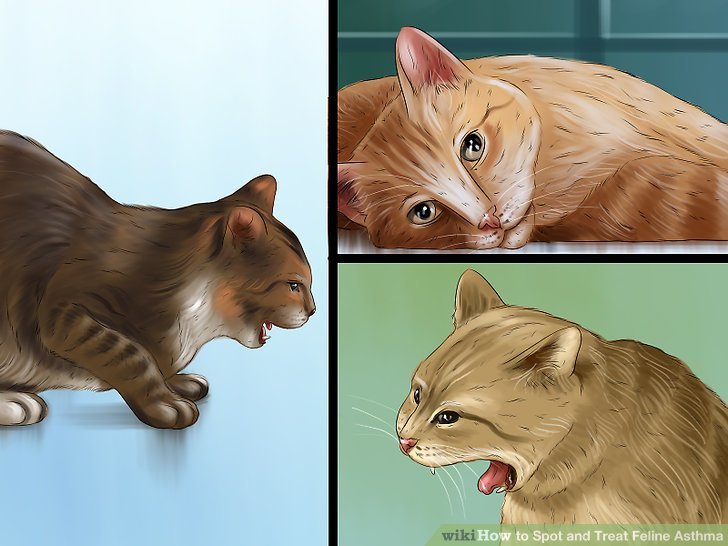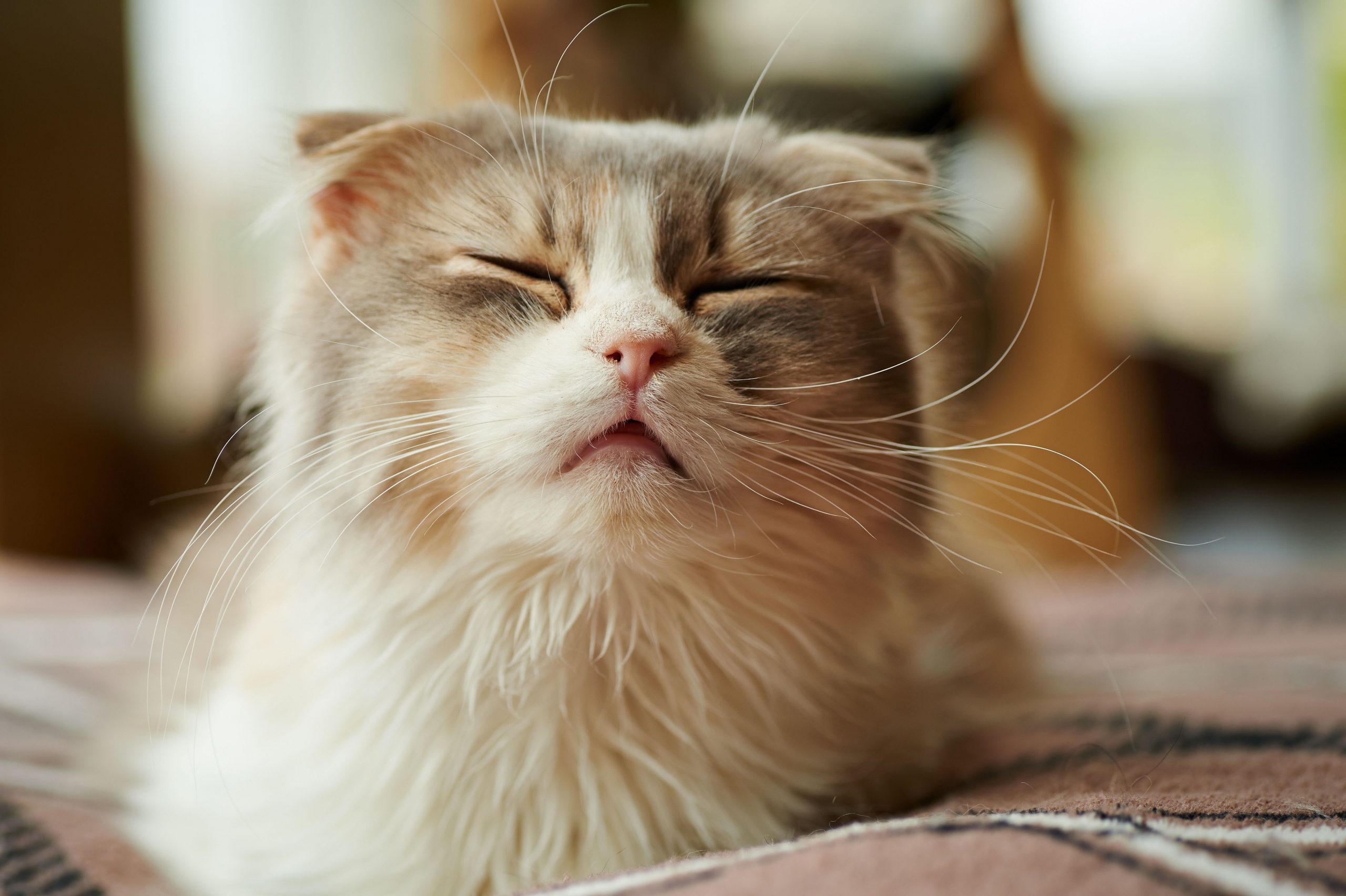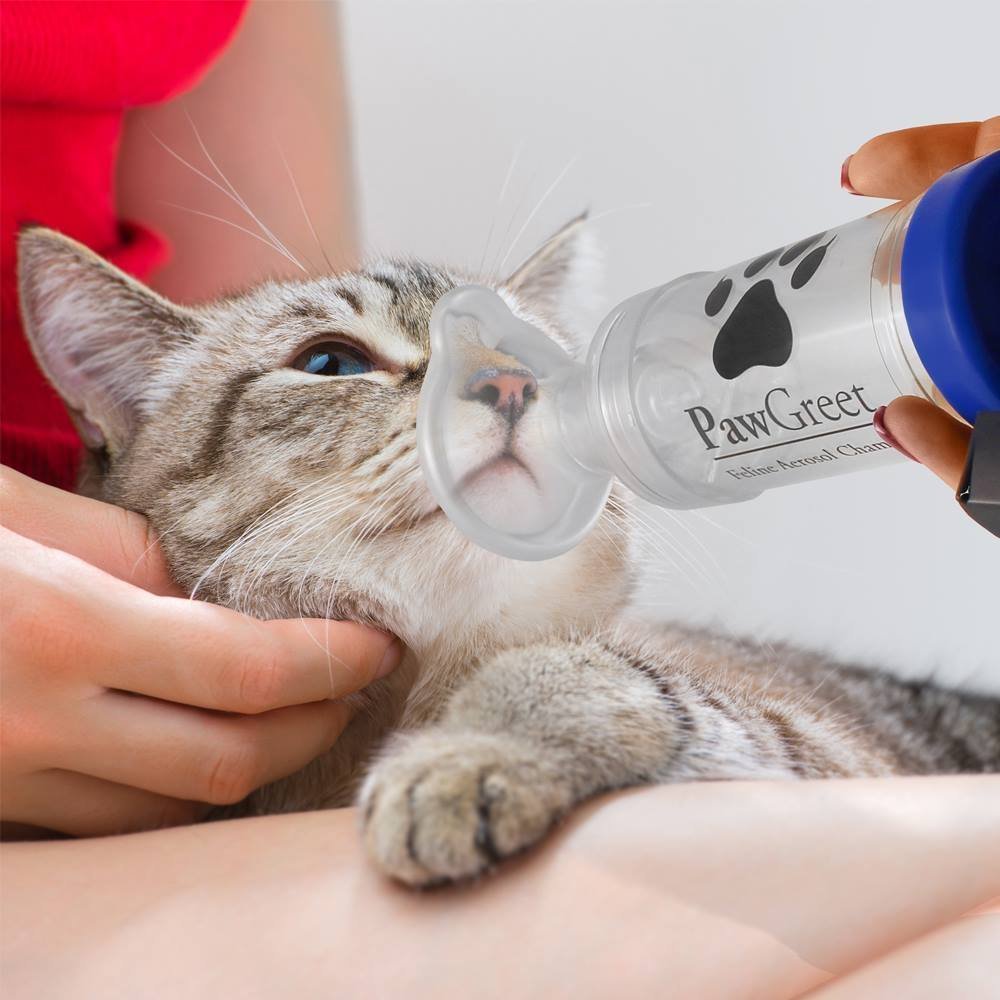Natural Solutions For Coughing And Asthma Support In Dogs & Cats
Chronic coughing and breathing difficulties can be one of the most difficult symptoms for your veterinarian to diagnose. There is a wide array of possibilities for the origin of a cough in a dog or cat. Something as simple as drinking water too fast can cause a fit of coughing, but when an animal coughs throughout the day or periodically for days in a row its time to start looking for the reason.
There are many possible causes of a cough including infectious diseases like kennel cough, distemper, bronchitis, or an upper respiratory infection such as feline viral rhinotracheitis , feline calicivirus and others in cats. Additional ailments that can cause a cough or breathing difficulties include allergies, asthma, chronic bronchitis, cancer, collapsed trachea, heart disease, heartworms, parasites, periodontal disease, pneumonia, or environmental irritants such as smoke and other pollutants.
Diagnosing the source of a chronic cough or breathing difficulties can take a good deal of investigation and requires the assistance of your veterinarian. Thorough assessment of the history of the cough and a physical examination are the first steps. Additional tests may be necessary such as, blood work, analysis of fluid samples, fecal samples , x-rays or ultrasound.
Coughing can also be caused by heart conditions such as congestive heart disease and dilated cardiomyopathy. Please see the article “Heart Disease in Companion Animals” for more information.
Can Asthma In Cats Be Prevented
Although there is no cure, there are steps you can take to reduce the likelihood of your cat suffering an asthma attack. Allergy testing can be done to enable you to establish the root cause of the condition, and eliminate the relevant triggers wherever possible.
Avoid smoking around your pet or using perfumes, air fresheners or any aerosol products as they can worsen the condition, as can cat litters that create lots of dust or are scented. As stress can aggravate the disease, you should ensure your cat remains as relaxed as possible at all times.
Obesity can also increase the severity of the condition so its important to keep your cat in shape and provide a good diet.
Its also a good idea to keep a diary of any asthma attacks your cat suffers, recording the time and date, severity and treatment given to build up a picture of any seasonal patterns or environmental factors that can trigger symptoms in your pet. Taking a video to show your vet can be very helpful.
What Causes Feline Asthma
Before going further, let’s tackle what cat asthma actually is.
Feline asthma is an immunity-related medical condition. It occurs when there is inflammation of the small passageways in the lungs.
The asthma attacks can be brought on by stress or by allergens.
These include allergens such as grass, pollen, dust mites, cat litter, tobacco, cat litter, household cleaning products, and even certain foods.
The symptoms of asthma can be:
- Wheezing
- Difficulty with breathing or rapid breathing
- Persistent cough or gagging
- Frothy mucus produced with cough
- Keeping mouth open while breathing
- Breathing difficulties after activity
- Neck extends outwards while struggling to breathe
- Squatting low to the ground with the neck extended
- Weakness and lethargy
- Gargling noise from throat
- Blue gums and lips
The disease cant be cured, but it can be managed with proper precautions and the right treatment.
Recommended Reading: Whats An Asthma Attack
Reducing Occurrences Of Asthma In Cats
While asthma has no cure, removing risk factors, such as spray aerosols or scented cat litter, can go some way in reducing the likelihood of it developing.
Indeed, the specialist mentioned above advocated getting rid of carpets and banning cats from sleeping on the bed neither of which she did!
In addition to removing triggers for asthma, you should also reduce any stress to which your cat is exposed, provide a high-quality food, switch to a dust-free litter and dont miss any vet appointments.
What Does Acute Management Mean For An Asthmatic Cat

Acute management also includes home treatment of acute asthma attacks that are not severe enough to warrant emergency presentation to a veterinary facility. Acute exacerbations may result from exposure to asthma triggers. This usually manifests as episodes of spasmodic coughing and increased expiratory effort.
Also Check: Nocturnal Asthma Or Sleep Apnea
Modify Your Cats Diet
Ensure your cat is fed a well-balanced diet. A complete, wholesome diet gives your cat the nutrition they need to keep their immune system as healthy as possible.
A low-allergen diet may help reduce inflammation and reduce instances of asthma attacks. Ask your vet for recommendations before switching your cats food.2
What Causes Feline Asthma And Bronchitis
The actual cause of the inflammation associated with feline asthma and bronchitis is unknown. It is better to consider triggers that enhance the inflammation and cause asthma and bronchitis signs. These triggers may include:
- dust from cat litter
- scented laundry detergent and/or fabric softeners
- mold/mildew
- essential oil diffusers
Read Also: Can You Join The Army If You Have Asthma
What Causes Asthma In Cats
Asthma in cats is an immunity-related condition and attacks can often be brought on by an allergy or stress. Suspected triggers include pollen, grass, mould, dust mites, tobacco smoke, cat litter, household cleaning products and even some foods.
The condition usually develops between the ages of two and eight years old, with a slightly higher prevalence in female cats. Certain breeds also have a genetic disposition to the condition, such as Siamese and Himalayan cats.
How Should We Treat Cats With Asthma
Treatment of feline asthma if symptoms are intermittent
In these cases I prescribe an albuterol inhaler with instructions to use “as needed”. The assumption in these cases is that cats with symptoms that do not occur daily do not have significant chronic inflammation that requires daily anti-inflammatory therapy. When acute signs do occur they can usually be effectively and quickly treated with the inhaled bronchodilator. If signs become more frequent the cat should be re-evaluated to determine if more aggressive treatment should be initiated .
Treatment of feline asthma if symptoms occur daily
High dose, long term corticosteroids.
The most consistent, most reliable, and most effective treatment for feline asthma is high dose, long term oral corticosteroids. I begin treatment of asthmatic cats with prednisone, 1-2 mg/kg po bid for 10-14 days. At this point the majority of newly diagnosed cats with asthma will feel and act much better. Once a beneficial response to oral prednisone has been documented i begin inhaled steroids as i wean the patient from oral prednisone
You May Like: Albuterol Inhaler Ingredients
How To Use The Inhaler
Your cat inhaler has to have a spacer device, since you cant tell the cat to take a breath. Make sure you get one that is specifically designed for cats.
Then you know the device will fit properly and that the medication gets delivered to your kittys lungs.
Get your cat used to the device before adding medication. Slowly and calmly familiarize the cat with the chamber. Give lots of love, hugs, and treats.
Start by just using the mask, gradually building up to holding it on your cats face for 20 to 30 seconds. Once the cat is comfortable with the mask, attach it to the chamber and get your cat used to the whole device.
With the inhaler, there is a chamber that has a specialized valve designed for the low air inflow in cats. The valve opens easily with shallow breaths thus the medication will flow easily from the chamber into your cats lungs.
The inhaler comes with an inhalation indicator, which moves when your cat inhales. Thus you can confirm that the mask is sealed you can count breaths, ensure proper use, and know the medication has been delivered.
What Is The Prognosis For Feline Asthma
With appropriate treatment the prognosis is normally good. Many cats will require life-long therapy. Unfortunately some cats can have progressive signs despite treatment. Uncommonly in some asthmatic cats a severe attack can be fatal.
If you have any questions about your cat’s condition, or his or her treatment, please do not hesitate to contact us.
Also Check: What Happens If You Smoke Weed With Asthma
How Is Asthma Or Chronic Bronchitis Treated
In practice, both are currently treated in the same way, although asthmatic cats may benefit more from bronchodilator therapy .
Generally, any secondary infections should be identified and treated, and any predisposing or exacerbating causes identified and removed if possible. This would include:
- Managing any obesity
- Identifying any potential irritants or allergens in the house, for example: pollens, use of perfumes or sprays, use of dusty cat litter, smoking in the house
- In some cats the disease may be seasonal or may occur only when the cat is in certain rooms. In these situations, it may be possible to track down an irritant or allergen that triggers the disease with careful investigations
In most cats, specific trigger factors cannot be identified and so symptomatic treatment will be required. This is mainly based around anti-inflammatory and bronchodilator therapy:
What Is Allergic Asthma

First of all, its worth knowing how allergic asthma is different from other types of asthma.
Asthma happens when your airways get inflamed. Your airways take air into your lungs through your windpipe and bronchioles, which absorb oxygen into your blood through your lungs. Asthma can have various causes, including chronic allergies, having parents with asthma, or having an airway infection when youre young. An asthma flare-up may happen without warning or when exposed to triggers like stress or overexertion from exercise.
Allergic asthma, or allergy-induced asthma, happens when your airways get inflamed after exposure to an allergen. About 60 percent of everyone with asthma in the United States has this type. According to the Asthma and Allergy Foundation of America, about 30 percent of people with allergies have cat or dog allergies. Twice as many people have cat allergies than dog allergies.
Its easiest to know if you have this kind of asthma if you notice your symptoms during allergy seasons, such as the spring and fall when pollen is at high levels, or when youre directly exposed to triggers like cat dander or certain chemicals.
Also Check: What Happens When You Have Asthma
When To See An Allergist
It can be difficult to pinpoint whether cats are actually the source of your allergic asthma. Cat allergens can combine with other possible triggers to making your symptoms disruptive to your life. Asthma can also get worse over time if its not treated.
An allergist can use tests to specify what exactly exacerbates your asthma symptoms and help you build up your immune system to tolerate them. Immunity is important if you want to keep your feline baby around long term.
What Is Asthma And Feline Bronchitis
Asthma is a common respiratory condition in cats. The disease is caused by activation of inflammation in the lungs in response to irritants or allergens in the environment. The cells in the lungs respond by increased production of mucus and reversible narrowing of the small airways. The condition is similar to the well described human form of the disease. In most cases the exact cause or trigger is unknown. A similar condition exists called chronic bronchitis. This shares many similarities with asthma. In cats with chronic bronchitis inflammation of the small airways is present however the reversible spasm is not.
You May Like: What To Do When Having An Asthma Attack Without Inhaler
Teaching Your Cat To Accept An Inhaler
Complete these steps slowly over a couple of weeks, its really important that the training isnt rushed and that your cat is happy with each stage before moving onto the next.
When your cat is happy having their nose in the mask for a short period of time, deliver their medication as instructed by your vet. Reward them with a treat afterwards.
Prednisone Or Prednisolone Whats Thedifference
No, its not a spelling mistake. Prednisolone and prednisone are two slightly different things. Many asthma cat parents talk about using prednisone to treat their feline but its more likely that prednisolone has been prescribed. Basically, prednisone is broken down by enzymes in the liver and turned into prednisolone, so its much safer for cats to be prescribed the end result in the first place, especially if there are other liver function factors involved.
It doesnt make much difference what you call it, so if you want to save yourself a couple of syllables, referring to it as prednisone is cool, as long as you remember what it actually is. For the sake of this piece Im going to refer to prednisolone because thats what Sparrow has been prescribed, but what Im going to say can probably be applied to both.
Don’t Miss: Does Weight Gain Make Asthma Worse
What Are The Signs Of Asthma Or Chronic Bronchitis In Cats
The signs of asthma or chronic bronchitis vary in severity between individuals. In addition, the signs may be either persistent or episodic. Typical signs include:
- Persistent coughing *
- Laboured and/or fast breathing
- Noisy breathing and wheezing
- Difficulty in breathing
*note that coughing in cats can look a little like the cat is trying to be sick, and may be mistaken for hairballs as the cat may retch or gag after coughing with their neck stretched out. Taking a video to show your vet is the best way to establish if the cat is truly coughing.
What Are The Signs
The signs of both conditions are similar and can vary in severity and frequency. The most common include:
Some cats can have a sudden life-threatening asthma attack. The signs of this would include breathing difficulties, open mouth breathing and weakness/collapse. This can happen in cats with previously diagnosed asthma or can be the first sign in some cases. Immediate veterinary attention is required in any cat with these signs at home.
Recommended Reading: Weight Induced Asthma
Medications To Treat Cat Asthma
Long-term medications to treat asthma in cats involve decreasing inflammation in the lungs. Your veterinarian may recommend:
Oral steroids : These medications are usually the first medication prescribed to cats after an asthma attack. Your cat will start out with a strong dose, and slowly decrease the dose to a level safer for long-term use. A common example is prednisolone.
Inhaled steroids: These medications are placed through an inhaler, which is connected to a system made especially for cats. Many cats can be acclimated to this inhaler, which looks like a small clear face mask. It may be safer than oral steroids for certain cats. A common example is fluticasone propionate.
Bronchodilators : Occasionally cats that do not respond well to just steroids may also be given this medication, which directly acts on the airway to open it up. A common example is terbutaline.
Immunosuppressants : Occasionally cats that cannot be given steroids may be managed on this, which decreases the entire immune system including in the lungs. An example is cyclosporine.
General Cost To Treat Asthma In Cats

If your cat is diagnosed with asthma but is not currently in an emergency situation, the cost for treatment could be anywhere from $300 to $600, depending on what kind of testing is required to determine a cause. Your cat may also need long-term medications to treat chronic asthma, which vary in cost.
If your cat experiences an asthma attack and requires emergency care, the cost could be anywhere from $800 to $1,500.
Don’t Miss: What Does A Nebulizer Do For Asthma
Prognosis For Cats With Asthma
What is the life expectancy of a cat with asthma? Asthma in cats is an incurable and often progressive condition, which means that if your cat has asthma they are likely to experience periodic flare-ups that can vary in intensity from mild to life-threatening.
That said, asthma is manageable in cats with a little extra care from pet parents and appropriate medications. By monitoring your cat’s respiratory effort, watching for coughing, and intervening with medication when needed, you can help your asthmatic cat live happily for years.
How Does Asthma Affect Cats
When an asthma attack occurs, these passageways thicken and constrict, making it very difficult for a cat to breathe. This often leads to respiratory distress, which can become grave in a matter of minutes. The lungs may also begin to discharge mucus into the airways, leading to fits of coughing and wheezing.
Read Also: Ways To Help Asthma
How To Spot And Treat Feline Asthma
This article was co-authored by Lauren Baker, DVM, PhD. Dr. Baker is a Veterinarian and PhD candidate in Comparative Biomedical Sciences. Dr. Baker received her Doctor of Veterinary Medicine from the University of Wisconsin in 2016, and went on to pursue a PhD through her work in the Comparative Orthopaedic Research Laboratory. This article has been viewed 10,697 times.
Feline asthma is a chronic swelling and irritation of a feline’s airway. In severe cases, the condition can be fatal and should be treated as soon as possible. Spotting asthma in felines requires that you assess the cat’s general health and look for signs that it is having trouble breathing. Once you suspect that your cat may have asthma, you should have it looked at by a veterinarian and begin treatment. With a little bit of effort on your part, and with the help of your veterinarian, you can spot and treat asthma in your cat.
